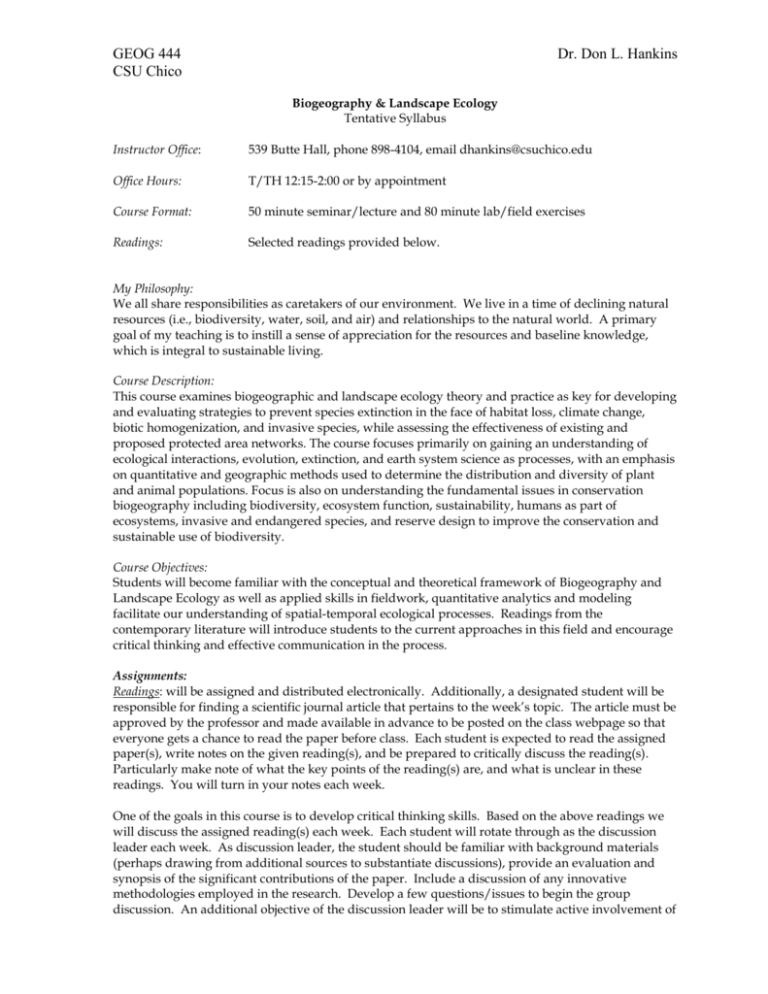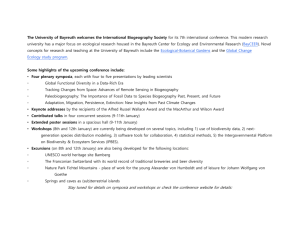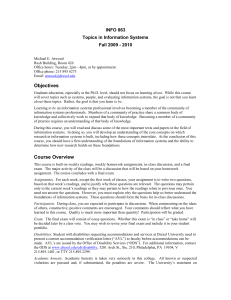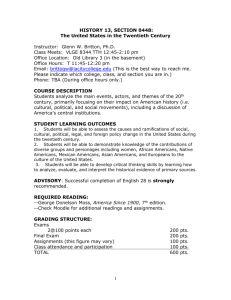GEOG 444 Section 01
advertisement

GEOG 444 CSU Chico Dr. Don L. Hankins Biogeography & Landscape Ecology Tentative Syllabus Instructor Office: 539 Butte Hall, phone 898-4104, email dhankins@csuchico.edu Office Hours: T/TH 12:15-2:00 or by appointment Course Format: 50 minute seminar/lecture and 80 minute lab/field exercises Readings: Selected readings provided below. My Philosophy: We all share responsibilities as caretakers of our environment. We live in a time of declining natural resources (i.e., biodiversity, water, soil, and air) and relationships to the natural world. A primary goal of my teaching is to instill a sense of appreciation for the resources and baseline knowledge, which is integral to sustainable living. Course Description: This course examines biogeographic and landscape ecology theory and practice as key for developing and evaluating strategies to prevent species extinction in the face of habitat loss, climate change, biotic homogenization, and invasive species, while assessing the effectiveness of existing and proposed protected area networks. The course focuses primarily on gaining an understanding of ecological interactions, evolution, extinction, and earth system science as processes, with an emphasis on quantitative and geographic methods used to determine the distribution and diversity of plant and animal populations. Focus is also on understanding the fundamental issues in conservation biogeography including biodiversity, ecosystem function, sustainability, humans as part of ecosystems, invasive and endangered species, and reserve design to improve the conservation and sustainable use of biodiversity. Course Objectives: Students will become familiar with the conceptual and theoretical framework of Biogeography and Landscape Ecology as well as applied skills in fieldwork, quantitative analytics and modeling facilitate our understanding of spatial-temporal ecological processes. Readings from the contemporary literature will introduce students to the current approaches in this field and encourage critical thinking and effective communication in the process. Assignments: Readings: will be assigned and distributed electronically. Additionally, a designated student will be responsible for finding a scientific journal article that pertains to the week’s topic. The article must be approved by the professor and made available in advance to be posted on the class webpage so that everyone gets a chance to read the paper before class. Each student is expected to read the assigned paper(s), write notes on the given reading(s), and be prepared to critically discuss the reading(s). Particularly make note of what the key points of the reading(s) are, and what is unclear in these readings. You will turn in your notes each week. One of the goals in this course is to develop critical thinking skills. Based on the above readings we will discuss the assigned reading(s) each week. Each student will rotate through as the discussion leader each week. As discussion leader, the student should be familiar with background materials (perhaps drawing from additional sources to substantiate discussions), provide an evaluation and synopsis of the significant contributions of the paper. Include a discussion of any innovative methodologies employed in the research. Develop a few questions/issues to begin the group discussion. An additional objective of the discussion leader will be to stimulate active involvement of all the class members and part of the leader’s evaluation will be based on this. Allow everyone a chance to speak. Keep discussion on topic. Keep the group engaged with new questions, issues, perspectives. Exams: A midterm and final exam will be given. Lab: The labs will generally meet weekly, sometimes off-site or on an alternate day, with the goal of gaining hands-on experience with the tools and techniques used in biogeographic and ecological studies. Assignments will be due at the beginning of class one week after assigned unless otherwise indicated. Research Paper Due 6 May: After you have collected your data, you will complete the second major component of your research project by writing your research paper (or summary of activities, etc.). As stated in the syllabus, the format will be in the form of a brief paper. Your paper should be approximately 1000 words (three pages double spaced 12 point font). Begin your article with an abstract no more than 150 words in length. The remainder of the paper should follow standard scientific manuscript format (Introduction, Methods, Results, Discussion, and Literature Cited), and following the Turabian Citation format. Due to the short length of the article, Results and Discussion may be combined. The 1000-word limit does not include title or authors or literature cited sections, but does include the abstract. If your topic does not fit well with these guidelines (e.g. you’re reporting on an outreach program), you may modify the format. Be sure to italicize scientific names. You are encouraged to include a map (can be hand-drawn) and other relevant graphics to display your data, these do not count against your page or word limit. Development of an original research paper/report is fundamental to this assignment. Submission of plagiarized materials will result in failure. One paper and one electronic copy of your research should be submitted. Instruction for electronic submission will be provided at a future date. Rubric for research paper (45 Pts.): 1) Presentation of problem statement/relevant literature review (15) 2) Statement of research question/Hypothesis(es) (7.5) 3) Methods and data analysis (15) 4) Grammar, spelling and clarity (7.5) Presentation 6 May: The final component of this process is to present an oral/poster presentation of your paper during finals week. Your presentation should be 5 minutes in duration (unless we choose to do them during finals week). Rubric for presentation (15 Pts.): 1) Background/literature review (3) 2) Problem Statement/Intro (3) 3) Methodology / Findings (3) 4) Discussion (3) 5) Clarity of delivery (3) Attendance: Attendance is part of the participation grade as there is a considerable amount of information that is presented each meeting that is not in the readings. With this said, life happens, and you may miss one class meeting before affecting your participation points. Grading: Grades will be assigned on a straight scale based on the points earned for each assignment (See example grade ranges below). This system will enable each student to earn a fair grade based upon the percent of points earned on assignments rather than competing with others in the class for the top grade. One late homework assignment will be accepted without an excused absence. Other late assignments will have 10 % deducted for each day they are late, and no assignments will be accepted more than one week (two class days) after the due date. All written assignments based on assigned readings will be due one week from the date assigned unless otherwise advised. Spelling, grammar, and composition will be considered part of the grading of major writing assignments 2 A AB+ B B- Incompletes will only be considered if most of the course requirements have been fulfilled. Written assignments should be based on primary sources, not the internet. Take responsibility to complete original and punctual assignments. 0.935 0.90 0.87 0.835 0.80 C+ C CD+ D 0.77 0.735 0.70 0.67 0.635 Participation and attendance In-class topic presentation(s) Homework/Assignments (10 pts. each) Research Paper Presentation Midterm Final exam Total 30 20 70-100 50 15 50 50 375 points points points points points points points points (Note: these values are an approximation of point allocation. Additional points for other assignments may be assigned at instructor’s discretion) Class Rules: Aside from University policies, respect the learning environment and the opinions/contributions of others, learn (and share what you have learned), have fun (laugh a little), and engage in the class topics. Please avoid tangential conversations and cellular phone use/text messaging during instruction. Laptop and portable device use can be disruptive, and is discouraged. Tentative Activity Schedule/Learning Objectives: Lecture/Date* Week 1 21-23 January Week 2 28-30 January Topic(s) Overview and Context of Biogeography History of Biogeography Controls of Biodiversity Tentative Readings/Activity Foundations NO LAB Learning Objective(s) Interpret the foundations of the subdiscipline biogeography Scale and Hierarchy Identify the primary controls of biodiversity Synthesize the scale of organismal interaction Ecological Hierarchy Week3 4-6 February Communities and Ecosystems Physical Considerations Landscape Context and Richness Interpret the role of heterogeneity at a landscape scale Landscape Elements Week 4 11-13 February Processes & Succession Sampling Week 5 Taxonomic Herbarium/Vertebrate 3 Identify patterns of ecological interactions Compare methods for assessing diversity Use keys to distinguish biotic 18-20 February Week 6 25-27 February Week 7 4-6 March Week 8 11-13 March Organization Measuring Diversity Distributions and Range Dispersal and Vicariance Museum Weekend Fieldtrip Tentative Working with Data Policy Endemism & Islands Island Biogeography Week 9 17-21 March Week 10 25-27 March Week 11 1-3 April Week 12 8-10 April Week 13 15-17 April Week 14 22-24 April Week 15 29 April-1 May Week 16 6-8 May Week 17 variation Identify and implement appropriate methodology for sampling diversity Assess the optimal conditions for species occurrence Identify the role of barriers in distributions Contrast the role of distance and area on biodiversity Water Manipulation Spring Break Measuring Landscapes Natural Selection and Genetic Considerations Ecological Interactions Paleobiogeography & Climate Change Conservation Biogeography Marine Biogeography Fieldwork or Catchup Semivariance and Autocorrelation Population Viability Analysis Weekend Fieldtrip Tentative NO LAB Reserve Design and Prioritization Weekend Fieldtrip Tentative NO LAB Identify and implement appropriate methodology for sampling landscapes Describe and synthesize the importance of genetic interaction for species Assess the linkages between organisms within the ecosystem Appreciate the methods and shifts in regional diversity across time Identify the methods used to facilitate biodiversity conservation Contrast the patterns of marine to terrestrial habitats Final Exam Thursday 15 May 10:00-11:50 4








